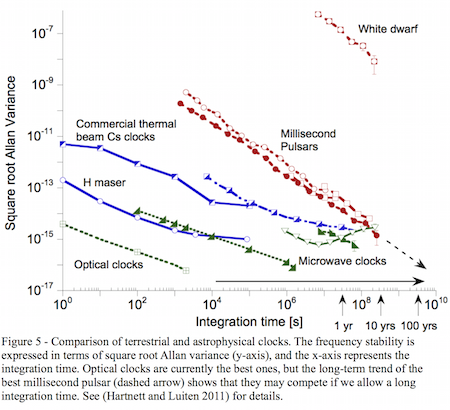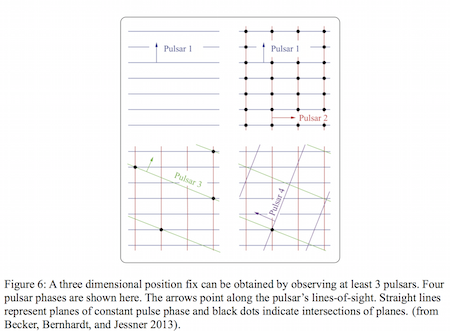Science Fiction
Dictionary
A B C D E F G H I J K L M N O P Q R S T U V W X Y Z
Is 'The Pulsar Positioning System' Evidence For SETI?

Clément Vidal, author of a new paper about astrophysics and the search for extraterrestrial intelligence, poses an interesting question about pulsars:
In the view of the author, pulsars could not only be used as a navigation system but are also sufficiently good clocks that they could be used to synchronize the work of a civilization.
To emphasize the significance of this research program, imagine that we would find around Mars’ orbit well-distributed timekeeping devices with a precision comparable to atomic clocks, beaming timing information that can be used as a “Mars Positioning System”, just like GPS. Wouldn’t we be compelled to explore the hypothesis that extraterrestrial intelligence is at play? This is exactly the current situation with millisecond pulsars, but on a galactic scale.

(Astrophysical vs. Terrestrial clocks)
First, all pulsars could be perfectly natural, but we can reasonably expect that civilizations in the galaxy will use them as standards (section 6). By studying and using XNAV, we are also getting potentially ready to receive and send messages to extraterrestrial intelligence in a galactically meaningful way. From now on, we might be able to decipher a first level of timing and positioning metadata in any galactic communication. We made a first risk-benefit analysis of asking permission to use PPS, but this largely remains to be debated.Second, what remains uncertain is whether the pulsar positioning system is natural or artificial. We put forward the SETI-XNAV quest to answer this issue. It draws on pulsar astronomy, and navigation and positioning science to make SETI predictions. This concrete project is grounded in a universal problem and need: navigation. Decades of pulsar empirical data is available, and I have proposed 9 lines of inquiry to start the endeavor (section 5). These include predictions regarding the spatial and power distribution of pulsars in the galaxy, their population, their evolutionary tracks, possible synchronization between pulsars, testing the navigability near the speed of light, decoding galactic coordinates, testing various directed panspermia hypotheses, as well as decoding metadata or more information in pulsar’s pulses.
As far as I know, the earliest reference to this idea is in George O. Smith's 1952 story Troubled Star; he described a space beacon.
In his paper, Vidal states that by observing three or more pulsars, a position can be determined.

(A fix requires at least 3 pulsars)
In his 1959 short story The Repairman, Harry Harrison wrote about automated hyperspace beacons placed at ideal locations on lonely planets, as well as the number of beacons needed to determine one's position in the galaxy:
The first ships to enter hyperspace had no place to go - and no way to tell if they had even moved. The beacons solved that problem and opened up the entire universe. They are built on planets and generate tremendous amounts of power...For a hyperspace jump, you need at least four beacons for an accurate fix. For long jumps, navigators use up to seven or eight. So every beacon is important and every one has to keep operating...
(Read more about Harry Harrison's hyperspace beacons)
Via Pulsar Positioning System: A quest for evidence of extraterrestrial engineering. Thanks to Winchell Chung (@nyrath) and Adam Crowl (@qraal)
Scroll down for more stories in the same category. (Story submitted 3/30/2017)
Follow this kind of news @Technovelgy.| Email | RSS | Blog It | Stumble | del.icio.us | Digg | Reddit |
Would
you like to contribute a story tip?
It's easy:
Get the URL of the story, and the related sf author, and add
it here.
Comment/Join discussion ( 0 )
Related News Stories - (" Space Tech ")
Will Space Stations Have Large Interior Spaces Again?
'They filed clumsily into the battleroom, like children in a swimming pool for the first time, clinging to the handholds along the side.' - Orson Scott Card, 1985.
Reflect Orbital Offers 'Sunlight on Demand' And Light Pollution
'I don't have to tell you about the seven two-mile-diameter orbital mirrors...'
Chrysalis Generation Ship to Alpha Centauri
'This was their world, their planet —
this swift-traveling, yet seemingly moveless vessel.' - Nat Schachner, 1934
The First Space Warship For Space Force
'Each of the electrical ships carried about twenty men...' - Garrett P. Serviss, 1898.
Technovelgy (that's tech-novel-gee!) is devoted to the creative science inventions and ideas of sf authors. Look for the Invention Category that interests you, the Glossary, the Invention Timeline, or see what's New.
Science Fiction
Timeline
1600-1899
1900-1939
1940's 1950's
1960's 1970's
1980's 1990's
2000's 2010's
Current News
Golf Ball Test Robot Wears Them Out
"The robot solemnly hit a ball against the wall, picked it up and teed it, hit it again, over and again...'
Boring Company Vegas Loop Like Asimov Said
'There was a wall ahead... It was riddled with holes that were the mouths of tunnels.'
Rigid Metallic Clothing From Science Fiction To You
'...support the interior human structure against Jupiter’s pull.'
Is The Seattle Ultrasonics C-200 A Heinlein Vibroblade?
'It ain't a vibroblade. It's steel. Messy.'
Roborock Saros Z70 Is A Robot Vacuum With An Arm
'Anything larger than a BB shot it picked up and placed in a tray...'
A Beautiful Visualization Of Compact Food
'The German chemists have discovered how to supply the needed elements in compact, undiluted form...'
Bone-Building Drug Evenity Approved
'Compounds devised by the biochemists for the rapid building of bone...'
Secret Kill Switch Found In Yutong Buses
'The car faltered as the external command came to brake...'
Inmotion Electric Unicycle In Combat
'It is about the size and shape of a kitchen stool, gyro-stabilized...'
Grok Scores Best In Psychological Tests
'Try to find out how he ticks...'
PaXini Supersensitive Robot Fingers
'My fingers are not that sensitive...'
Congress Considers Automatic Emergency Braking, One Hundred Years Too Late
'The greatest problem of all was the elimination of the human element of braking together with its inevitable time lag.'
The Desert Ship Sailed In Imagination
'Across the ancient sea floor a dozen tall, blue-sailed Martian sand ships floated, like blue smoke.'
The Zapata Air Scooter Would Be Great In A Science Fiction Story
'Betty's slapdash style.'
Thermostabilized Wet Meat Product (NASA Prototype)
There are no orbiting Michelin stars. Yet.
Could Crystal Batteries Generate Power For Centuries?
'Power could be compressed thus into an inch-square cube of what looked like blue-white ice'
